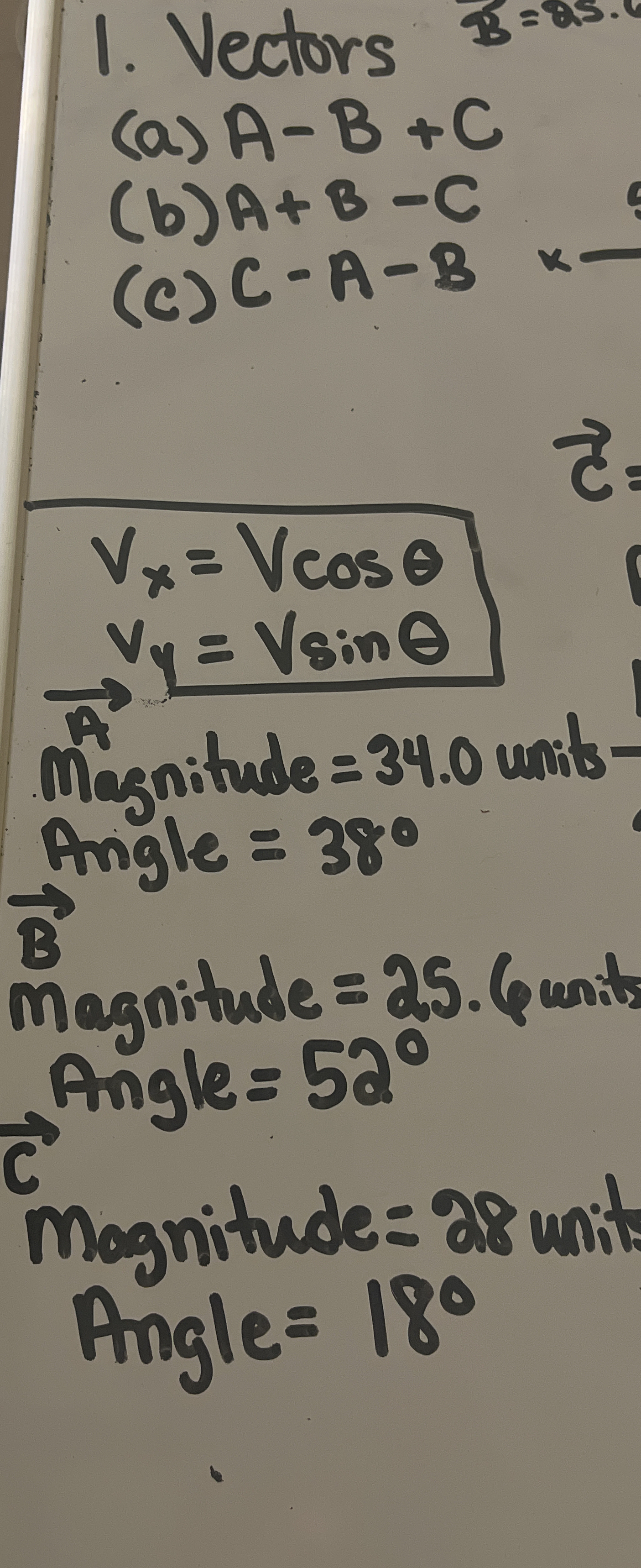1. Vectors (a) A - B + C (b) A + B - C (c) C - A - B

Understand the Problem
The question involves performing vector operations, specifically vector addition and subtraction using given magnitudes and angles for three vectors (A, B, C). The formulas for resolving the vectors into their components are provided, and it appears that the user is interested in calculating the resultant vectors.
Answer
The magnitude is approximately $16.4$ units and the angle is found using $ \theta = \tan^{-1}\left(\frac{0.8}{-16.4}\right)$.
Answer for screen readers
The resultant vector for ( A - B + C ) has a magnitude of approximately 16.4 units and an angle approximately equal to ( \tan^{-1}(-0.0488) ).
Steps to Solve
- Resolve Vectors into Components
For each vector, we will resolve it into its x and y components using the formulas provided.
-
For vector A:
- ( A_x = 34.0 \cos(38^\circ) )
- ( A_y = 34.0 \sin(38^\circ) )
-
For vector B:
- ( B_x = 25.6 \cos(52^\circ) )
- ( B_y = 25.6 \sin(52^\circ) )
-
For vector C:
- ( C_x = 28.0 \cos(180^\circ) )
- ( C_y = 28.0 \sin(180^\circ) )
- Calculating Individual Components
Now, we can calculate the actual values for each component.
-
For vector A:
- ( A_x = 34.0 \cos(38^\circ) \approx 27.0 )
- ( A_y = 34.0 \sin(38^\circ) \approx 20.6 )
-
For vector B:
- ( B_x = 25.6 \cos(52^\circ) \approx 15.4 )
- ( B_y = 25.6 \sin(52^\circ) \approx 19.8 )
-
For vector C:
- ( C_x = 28.0 \cos(180^\circ) = -28.0 )
- ( C_y = 28.0 \sin(180^\circ) = 0 )
- Performing Vector Calculations (Example a: A - B + C)
We now perform the specified operations on the vectors.
For ( A - B + C ):
- Resultant components:
- ( R_x = A_x - B_x + C_x )
- ( R_y = A_y - B_y + C_y )
Substituting the values:
- ( R_x = 27.0 - 15.4 - 28.0 )
- ( R_y = 20.6 - 19.8 + 0 )
- Calculating Resultant Components
Now, calculate ( R_x ) and ( R_y ):
- ( R_x = 27.0 - 15.4 - 28.0 \approx -16.4 )
- ( R_y = 20.6 - 19.8 \approx 0.8 )
- Finding the Resultant Magnitude and Angle
Finally, we can find the magnitude and angle of the resultant vector:
-
Magnitude: $$ R = \sqrt{R_x^2 + R_y^2} $$ Substituting, $$ R = \sqrt{(-16.4)^2 + (0.8)^2} $$
-
Angle: $$ \theta = \tan^{-1}\left(\frac{R_y}{R_x}\right) $$
- Calculate the Final Values for Magnitude and Angle
Calculating these values gives:
- ( R = \sqrt{268.96 + 0.64} \approx \sqrt{269.6} \approx 16.4 )
- ( \theta = \tan^{-1}\left(\frac{0.8}{-16.4}\right) )
The resultant vector for ( A - B + C ) has a magnitude of approximately 16.4 units and an angle approximately equal to ( \tan^{-1}(-0.0488) ).
More Information
This method allows us to break down vectors into simpler components for easier calculation. Each vector can be resolved using trigonometric functions, and by summing or subtracting these components, we can find the resultant vectors.
Tips
- Forgetting to convert angles to radians if using a calculator set in radian mode.
- Confusing angles when performing vector subtractions, especially signs.
- Miscalculating trigonometric functions.
AI-generated content may contain errors. Please verify critical information